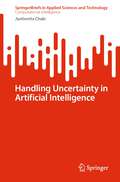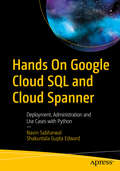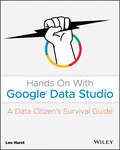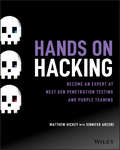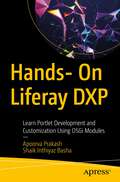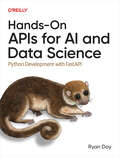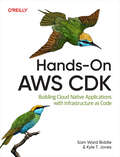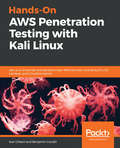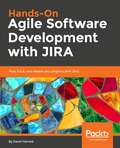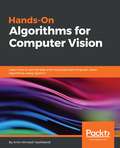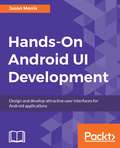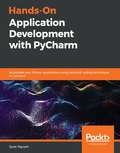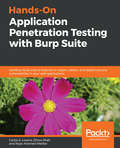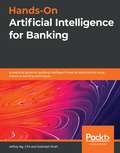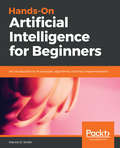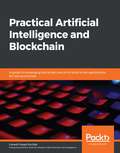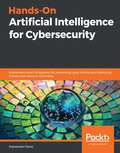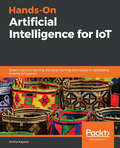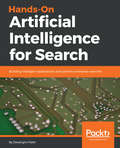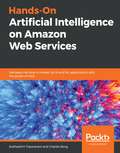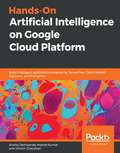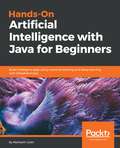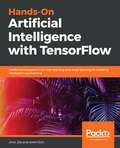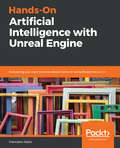- Table View
- List View
Handling Uncertainty in Artificial Intelligence (SpringerBriefs in Applied Sciences and Technology)
by Jyotismita ChakiThis book demonstrates different methods (as well as real-life examples) of handling uncertainty like probability and Bayesian theory, Dempster-Shafer theory, certainty factor and evidential reasoning, fuzzy logic-based approach, utility theory and expected utility theory. At the end, highlights will be on the use of these methods which can help to make decisions under uncertain situations. This book assists scholars and students who might like to learn about this area as well as others who may have begun without a formal presentation. The book is comprehensive, but it prohibits unnecessary mathematics.
Handmade Pixels: Independent Video Games and the Quest for Authenticity
by Jesper JuulAn investigation of independent video games—creative, personal, strange, and experimental—and their claims to handcrafted authenticity in a purely digital medium. Video games are often dismissed as mere entertainment products created by faceless corporations. The last twenty years, however, have seen the rise of independent, or “indie,” video games: a wave of small, cheaply developed, experimental, and personal video games that react against mainstream video game development and culture. In Handmade Pixels, Jesper Juul examine the paradoxical claims of developers, players, and festivals that portray independent games as unique and hand-crafted objects in a globally distributed digital medium. Juul explains that independent video games are presented not as mass market products, but as cultural works created by people, and are promoted as authentic alternatives to mainstream games. Writing as a game player, scholar, developer, and educator, Juul tells the story of how independent games—creative, personal, strange, and experimental—became a historical movement that borrowed the term “independent” from film and music while finding its own kind of independence.Juul describes how the visual style of independent games signals their authenticity—often by referring to older video games or analog visual styles. He shows how developers use strategies for creating games with financial, aesthetic, and cultural independence; discusses the aesthetic innovations of “walking simulator” games; and explains the controversies over what is and what isn't a game. Juul offers examples from independent games ranging from Dys4ia to Firewatch; the text is richly illustrated with many color images.
Hands On Google Cloud SQL and Cloud Spanner: Deployment, Administration and Use Cases with Python
by Navin Sabharwal Shakuntala Gupta EdwardDiscover the methodologies and best practices for getting started with Google Cloud Platform relational services – CloudSQL and CloudSpanner.The book begins with the basics of working with the Google Cloud Platform along with an introduction to the database technologies available for developers from Google Cloud. You'll then take an in-depth hands on journey into Google CloudSQL and CloudSpanner, including choosing the right platform for your application needs, planning, provisioning, designing and developing your application. Sample applications are given that use Python to connect to CloudSQL and CloudSpanner, along with helpful features provided by the engines. You''ll also implement practical best practices in the last chapter. Hands On Google Cloud SQL and Cloud Spanner is a great starting point to apply GCP data offerings in your technology stack and the code used allows you to try out the examples and extend them in interesting ways.What You'll LearnGet started with Big Data technologies on the Google Cloud Platform Review CloudSQL and Cloud Spanner from basics to administrationApply best practices and use Google’s CloudSQL and CloudSpanner offeringWork with code in Python notebooks and scriptsWho This Book Is ForApplication architects, database architects, software developers, data engineers, cloud architects.
Hands On With Google Data Studio: A Data Citizen's Survival Guide
by Lee HurstLearn how to easily transform your data into engaging, interactive visual reports! Data is no longer the sole domain of tech professionals and scientists. Whether in our personal, business, or community lives, data is rapidly increasing in both importance and sheer volume. The ability to visualize all kinds of data is now within reach for anyone with a computer and an internet connection. Google Data Studio, quickly becoming the most popular free tool in data visualization, offers users a flexible, powerful way to transform private and public data into interactive knowledge that can be easily shared and understood. Hands On With Google Data Studio teaches you how to visualize your data today and produce professional quality results quickly and easily. No previous experience is required to get started right away—all you need is this guide, a Gmail account, and a little curiosity to access and visualize data just like large businesses and organizations. Clear, step-by-step instructions help you identify business trends, turn budget data into a report, assess how your websites or business listings are performing, analyze public data, and much more. Practical examples and expert tips are found throughout the text to help you fully understand and apply your new knowledge to a wide array of real-world scenarios. This engaging, reader-friendly guide will enable you to: Use Google Data Studio to access various types of data, from your own personal data to public sources Build your first data set, navigate the Data Studio interface, customize reports, and share your work Learn the fundamentals of data visualization, personal data accessibility, and open data API's Harness the power of publicly accessible data services including Google’s recently released Data Set Search Add banners, logos, custom graphics, and color palettes Hands On With Google Data Studio: A Data Citizens Survival Guide is a must-have resource for anyone starting their data visualization journey, from individuals, consultants, and small business owners to large business and organization managers and leaders.
Hands on Hacking: Become an Expert at Next Gen Penetration Testing and Purple Teaming
by Matthew Hickey Jennifer ArcuriA fast, hands-on introduction to offensive hacking techniques Hands-On Hacking teaches readers to see through the eyes of their adversary and apply hacking techniques to better understand real-world risks to computer networks and data. Readers will benefit from the author's years of experience in the field hacking into computer networks and ultimately training others in the art of cyber-attacks. This book holds no punches and explains the tools, tactics and procedures used by ethical hackers and criminal crackers alike. We will take you on a journey through a hacker’s perspective when focused on the computer infrastructure of a target company, exploring how to access the servers and data. Once the information gathering stage is complete, you’ll look for flaws and their known exploits—including tools developed by real-world government financed state-actors. • An introduction to the same hacking techniques that malicious hackers will use against an organization • Written by infosec experts with proven history of publishing vulnerabilities and highlighting security flaws • Based on the tried and tested material used to train hackers all over the world in the art of breaching networks • Covers the fundamental basics of how computer networks are inherently vulnerable to attack, teaching the student how to apply hacking skills to uncover vulnerabilities We cover topics of breaching a company from the external network perimeter, hacking internal enterprise systems and web application vulnerabilities. Delving into the basics of exploitation with real-world practical examples, you won’t find any hypothetical academic only attacks here. From start to finish this book will take the student through the steps necessary to breach an organization to improve its security. Written by world-renowned cybersecurity experts and educators, Hands-On Hacking teaches entry-level professionals seeking to learn ethical hacking techniques. If you are looking to understand penetration testing and ethical hacking, this book takes you from basic methods to advanced techniques in a structured learning format.
Hands- On Liferay DXP: Learn Portlet Development and Customization Using OSGi Modules
by Apoorva Prakash Shaik Inthiyaz BashaExplore the development and customization of OSGi modules in Liferay DXP and choosing the right underlying technology for it.The book starts with the basic Liferay Architecture to understand how things work in Liferay DXP, as well as in OSGi. Next, you’ll understand Blade CLI, Liferay workspace and how you can develop portlet modules in different module templates. Once you are familiar with portlet modules, you’ll explore some advance concepts such as Inter Portlet Communications (IPC), message bus etc. Moving on, you’ll understand about building service layer using service builder and exposing web services. Later chapters will cover how to customize the default behavior of Liferay, Liferay services, and user interface using Hooks. Additionally, this book will cover topics like Gogo shell, xxpando attributes, basic integration with the Liferay search framework etc. By the end of this book, you should be able to develop portlet modules in Liferay DXP and customize the default Liferay behavior. What You'll LearnReview OSGI Concepts Use Liferay workspace and Blade CLI Develop Liferay Portlet modules Build services and web services using service builder Study customizations of Liferay default behavior and user interfaceWho This Book Is ForDevelopers who wish to learn Liferay DXP development approach to improve their productivity. It is best suited for those who possess basic Java knowledge and are familiar with Liferay User Interface.
Hands-On APIs for AI and Data Science
by Ryan DayTo succeed in AI and data science, you must first master APIs. API skills are essential for AI and data science success. With this practical book, data scientists and software developers will gain hands-on experience developing and using APIs with the Python programming language and popular frameworks like FastAPI and StreamLit.Part 1 takes you step-by-step through coding projects to build APIs using Python and FastAPI and deploy them in the cloud. Part 2 teaches you to consume APIs in a data science project using industry-standard tools. And in Part 3, you'll use ChatGPT, the LangChain framework, and other tools to access your APIs with generative AI and large language models (LLMs).As you complete the chapters in the book, you'll be creating a professional online portfolio demonstrating your new skill with APIs, AI, and data science.You'll learn how to:Design APIs that data scientists and AIs loveDevelop APIs using Python and FastAPIDeploy APIs using multiple cloud providersCreate data science projects such as visualizations and models using APIs as a data sourceAccess APIs using generative AI and LLMsAuthor Ryan Day is a data scientist in the financial services industry and an open source developer.
Hands-On AWS CDK
by Sam Ward Biddle Kyle T. JonesLooking to accelerate development and build cloud native applications with AWS Cloud Development Kit? Through hands-on projects, you'll learn the basics of AWS CDK, the tool of choice for many of the world's largest technology companies.Informed by real case studies and years of work with enterprise-scale cloud architectures, this book will benefit both novice and advanced cloud developers. It's complete with step-by-step explanations of essential concepts, practical examples, and self-assessment questions to help you build a shareable portfolio of completed projects, demonstrating your ability to build cloud infrastructure at scale.You'll explore:Basic cloud computing concepts, including the AWS Well-Architected FrameworkEnd-to-end cloud native software and infrastructure as codeThe benefits of a reusable code library to accelerate your projectsFunctional modules of code that can stand alone or build toward an integrated cloud application
Hands-On AWS Penetration Testing with Kali Linux: Set up a virtual lab and pentest major AWS services, including EC2, S3, Lambda, and CloudFormation
by Karl Gilbert Benjamin CaudillIdentify tools and techniques to secure and perform a penetration test on an AWS infrastructure using Kali LinuxKey FeaturesEfficiently perform penetration testing techniques on your public cloud instancesLearn not only to cover loopholes but also to automate security monitoring and alerting within your cloud-based deployment pipelinesA step-by-step guide that will help you leverage the most widely used security platform to secure your AWS Cloud environmentBook DescriptionThe cloud is taking over the IT industry. Any organization housing a large amount of data or a large infrastructure has started moving cloud-ward — and AWS rules the roost when it comes to cloud service providers, with its closest competitor having less than half of its market share. This highlights the importance of security on the cloud, especially on AWS. While a lot has been said (and written) about how cloud environments can be secured, performing external security assessments in the form of pentests on AWS is still seen as a dark art. This book aims to help pentesters as well as seasoned system administrators with a hands-on approach to pentesting the various cloud services provided by Amazon through AWS using Kali Linux. To make things easier for novice pentesters, the book focuses on building a practice lab and refining penetration testing with Kali Linux on the cloud. This is helpful not only for beginners but also for pentesters who want to set up a pentesting environment in their private cloud, using Kali Linux to perform a white-box assessment of their own cloud resources. Besides this, there is a lot of in-depth coverage of the large variety of AWS services that are often overlooked during a pentest — from serverless infrastructure to automated deployment pipelines.By the end of this book, you will be able to identify possible vulnerable areas efficiently and secure your AWS cloud environment.What you will learnFamiliarize yourself with and pentest the most common external-facing AWS servicesAudit your own infrastructure and identify flaws, weaknesses, and loopholesDemonstrate the process of lateral and vertical movement through a partially compromised AWS accountMaintain stealth and persistence within a compromised AWS accountMaster a hands-on approach to pentestingDiscover a number of automated tools to ease the process of continuously assessing and improving the security stance of an AWS infrastructureWho this book is forIf you are a security analyst or a penetration tester and are interested in exploiting Cloud environments to reveal vulnerable areas and secure them, then this book is for you. A basic understanding of penetration testing, cloud computing, and its security concepts is mandatory.
Hands-On Agile Software Development with JIRA: Design and manage software projects using the Agile methodology
by David HarnedPlan, track, and release great softwareKey Features Learn to create reports and dashboard for effective project management Implement your development strategy in JIRA. Practices to help you manage the issues in the development teamBook DescriptionAs teams scale in size, project management can get very complicated. One of the best tools to deal with this kind of problem is JIRA. This book will start by organizing your project requirements and the principles of Agile development to get you started. You will then be introduced to set up a JIRA account and the JIRA ecosystem to help you implement a dashboard for your team's work and issues. You will learn how to manage any issues and bugs that might emerge in the development stage. Going ahead, the book will help you build reports and use them to plan the releases based on the study of the reports. Towards the end, you will come across working with the gathered data and create a dashboard that helps you track the project's development.What you will learn Create your first project (and manage existing projects) in JIRA Manage your board view and backlogs in JIRA Run a Scrum Sprint project in JIRA Create reports (including topic-based reports) Forecast using versions Search for issues with JIRA Query Language (JQL) Execute bulk changes to issues Create custom filters, dashboards, and widgets Create epics, stories, bugs, and tasksWho this book is forThis book is for administrators who wants to apply the Agile approach to managing the issues, bugs, and releases in their software development projects using JIRA.
Hands-On Algorithms for Computer Vision: Learn how to use the best and most practical computer vision algorithms using OpenCV
by Amin Ahmadi TazehkandiCreate powerful, accurate, and real-time Computer Vision applications using a perfect blend of algorithms and filters. Also learn about object tracking and foreground extractions with a variety of new filters and algorithms.Key Features Filter, transform, and manipulate images using MAT class and OpenCV Framework Explore motion detection and object tracking with filters and algorithms Build object detectors using deep learning and machine learning algorithmsBook DescriptionAn arena that has been positively impacted by the advancements in processing power and performance is the field of computer vision. It's only natural that over time, more and more algorithms are introduced to perform computer vision tasks more efficiently. Hands-On Algorithms for Computer Vision is a starting point for anyone who is interested in the field of computer vision and wants to explore the most practical algorithms used by professional computer vision developers. The book starts with the basics and builds up over the course of the chapters with hands-on examples for each algorithm.Right from the start, you will learn about the required tools for computer vision development, and how to install and configure them. You'll explore the OpenCV framework and its powerful collection of libraries and functions. Starting from the most simple image modifications, filtering, and transformations, you will gradually build up your knowledge of various algorithms until you are able to perform much more sophisticated tasks, such as real-time object detection using deep learning algorithms.What you will learn Get to grips with machine learning and artificial intelligence algorithms Read, write, and process images and videos Perform mathematical, matrix, and other types of image data operations Create and use histograms from back-projection images Detect motion, extract foregrounds, and track objects Extract key points with a collection of feature detector algorithms Develop cascade classifiers and use them, and train and test classifiers Employ TensorFlow object detection to detect multiple objectsWho this book is forHands-On Algorithms for Computer Vision helps those who want to learn algorithms in Computer Vision to create and customize their applications. This book will also help existing Computer Vision developers customize their applications. A basic understanding of computer vision and programming experience is needed.
Hands-On Android UI Development
by Jason MorrisAbout This BookA comprehensive guide to designing and developing highly interactive user interfaces for your app.Design responsive and agile applications targeting multiple Android devices (up to Android Oreo) using Android Studio 3.0Write reactive user interfaces with minimal effort by leveraging the latest Android technologies, such as Architecture components and the Lifecycle APIAvoid common design problems and pitfalls with the help of shared UI design patterns and best practices.Who This Book Is ForThis book is for novice Android and Java developers who have a basic knowledge of Android development and want to start developing stunning user interfaces.What You Will LearnCreate effective and efficient user interfaces that allow users to carry out tasks smoothlyUnderstand the fundamentals of Android UI design, and take a look at the basic layouts, Inputs, and controlsLearn about various UI components provided by Android which includes structured layout objects and UI controls that allow you to build the graphical user interface for your app.Explore various styles and themes which allow you to customize the look and feel of your app.Leverage the animation and graphics APIs to improve user-experience and drawing custom 2D graphics.In DetailA great user interface can spell the difference between success and failure for any new application. Android UI Development will show you not just how to code great user interfaces, but how to design them as well. This book will take a novice Android developer on a journey, showing them how to leverage the Android platform to produce stunning Android applications. Starting with the basics of creating Android applications, this book progresses onto topics such as screen and layout design. After getting to grips with the basics you'll be shown techniques that create a better-perceived performance. You'll find out how to create reactive applications that are fast, animated and guide the user towards their goals with minimal distraction. You'll explore Android Architecture Components and how to build your application to automatically respond to changes made by the user. Great platforms are not always enough, so Android UI Development also covers creating custom components, layout managers, and 2D graphics. The book contains many tips to help show the best practices and easiest way forward. By the end, you'll be able to not just design & build amazing user interfaces, but also the systems that underpin a great user interface to provide the best possible user experience.
Hands-On Application Development with PyCharm: Accelerate your Python applications using practical coding techniques in PyCharm
by Quan NguyenA definitive guide to PyCharm to help you build business-oriented Python applications ranging from modern web development to data science Key Features Learn basic to advanced PyCharm concepts to improve efficiency of your Python projects Work through practical examples that focus on efficient application development with PyCharm Explore advanced features in PyCharm such as code automation, version control, and GUI debugging Book Description JetBrain's PyCharm is the most popular Integrated Development Environment (IDE) used by the Python community thanks to its numerous features that facilitate faster, more accurate, and more productive programming practices. However, the abundance of options and customizations can make PyCharm seem quite intimidating. Hands-on Application Development with PyCharm starts with PyCharm's installation and configuration process, and systematically takes you through a number of its powerful features that can greatly improve your productivity. You'll explore code automation, version control, graphical debugging/testing, management of virtual environments, and much more. Finally, you'll delve into specific PyCharm features that support web development and data science, two of the fastest growing applications in Python programming. These include the integration of the Django framework as well as the extensive support for IPython and Jupyter Notebook. By the end of this PyCharm book, you will have gained extensive knowledge of the tool and be able to implement its features and make the most of its support for your projects. What you will learn Explore PyCharm functionalities and what makes it stand out from other Python IDEs Set up, configure, and customize your Python projects in PyCharm Understand how PyCharm integrates with Django for web development Discover PyCharm's capabilities in database management and data visualization Perform code automation, GUI testing, and version control in PyCharm Integrate interactive Python tools such as Jupyter Notebooks for building virtual environments Who this book is for If you're a beginner or an expert Python user looking to improve your productivity using one of the best Python IDEs, this book is for you. Basic knowledge of Python programming language is expected.
Hands-On Application Penetration Testing with Burp Suite: Use Burp Suite and its features to inspect, detect, and exploit security vulnerabilities in your web applications
by Dhruv Shah Carlos A. Lozano Riyaz Ahemed WalikarTest, fuzz, and break web applications and services using Burp Suite’s powerful capabilitiesKey FeaturesMaster the skills to perform various types of security tests on your web applicationsGet hands-on experience working with components like scanner, proxy, intruder and much moreDiscover the best-way to penetrate and test web applicationsBook DescriptionBurp suite is a set of graphic tools focused towards penetration testing of web applications. Burp suite is widely used for web penetration testing by many security professionals for performing different web-level security tasks.The book starts by setting up the environment to begin an application penetration test. You will be able to configure the client and apply target whitelisting. You will also learn to setup and configure Android and IOS devices to work with Burp Suite. The book will explain how various features of Burp Suite can be used to detect various vulnerabilities as part of an application penetration test. Once detection is completed and the vulnerability is confirmed, you will be able to exploit a detected vulnerability using Burp Suite. The book will also covers advanced concepts like writing extensions and macros for Burp suite. Finally, you will discover various steps that are taken to identify the target, discover weaknesses in the authentication mechanism, and finally break the authentication implementation to gain access to the administrative console of the application.By the end of this book, you will be able to effectively perform end-to-end penetration testing with Burp Suite. What you will learnSet up Burp Suite and its configurations for an application penetration testProxy application traffic from browsers and mobile devices to the serverDiscover and identify application security issues in various scenariosExploit discovered vulnerabilities to execute commandsExploit discovered vulnerabilities to gain access to data in various datastoresWrite your own Burp Suite plugin and explore the Infiltrator moduleWrite macros to automate tasks in Burp SuiteWho this book is forIf you are interested in learning how to test web applications and the web part of mobile applications using Burp, then this is the book for you. It is specifically designed to meet your needs if you have basic experience in using Burp and are now aiming to become a professional Burp user.
Hands-On Artificial Intelligence for Banking: A practical guide to building intelligent financial applications using machine learning techniques
by Subhash Shah Jeffrey Ng, CFADelve into the world of real-world financial applications using deep learning, artificial intelligence, and production-grade data feeds and technology with Python Key Features Understand how to obtain financial data via Quandl or internal systems Automate commercial banking using artificial intelligence and Python programs Implement various artificial intelligence models to make personal banking easy Book Description Remodeling your outlook on banking begins with keeping up to date with the latest and most effective approaches, such as artificial intelligence (AI). Hands-On Artificial Intelligence for Banking is a practical guide that will help you advance in your career in the banking domain. The book will demonstrate AI implementation to make your banking services smoother, more cost-efficient, and accessible to clients, focusing on both the client- and server-side uses of AI. You'll begin by understanding the importance of artificial intelligence, while also gaining insights into the recent AI revolution in the banking industry. Next, you'll get hands-on machine learning experience, exploring how to use time series analysis and reinforcement learning to automate client procurements and banking and finance decisions. After this, you'll progress to learning about mechanizing capital market decisions, using automated portfolio management systems and predicting the future of investment banking. In addition to this, you'll explore concepts such as building personal wealth advisors and mass customization of client lifetime wealth. Finally, you'll get to grips with some real-world AI considerations in the field of banking. By the end of this book, you'll be equipped with the skills you need to navigate the finance domain by leveraging the power of AI. What you will learn Automate commercial bank pricing with reinforcement learning Perform technical analysis using convolutional layers in Keras Use natural language processing (NLP) for predicting market responses and visualizing them using graph databases Deploy a robot advisor to manage your personal finances via Open Bank API Sense market needs using sentiment analysis for algorithmic marketing Explore AI adoption in banking using practical examples Understand how to obtain financial data from commercial, open, and internal sources Who this book is for This is one of the most useful artificial intelligence books for machine learning engineers, data engineers, and data scientists working in the finance industry who are looking to implement AI in their business applications. The book will also help entrepreneurs, venture capitalists, investment bankers, and wealth managers who want to understand the importance of AI in finance and banking and how it can help them solve different problems related to these domains. Prior experience in the financial markets or banking domain, and working knowledge of the Python programming language are a must.
Hands-On Artificial Intelligence for Beginners: An introduction to AI concepts, algorithms, and their implementation
by Patrick D. SmithGrasp the fundamentals of Artificial Intelligence and build your own intelligent systems with easeKey FeaturesEnter the world of AI with the help of solid concepts and real-world use casesExplore AI components to build real-world automated intelligenceBecome well versed with machine learning and deep learning conceptsBook DescriptionVirtual Assistants, such as Alexa and Siri, process our requests, Google's cars have started to read addresses, and Amazon's prices and Netflix's recommended videos are decided by AI. Artificial Intelligence is one of the most exciting technologies and is becoming increasingly significant in the modern world.Hands-On Artificial Intelligence for Beginners will teach you what Artificial Intelligence is and how to design and build intelligent applications. This book will teach you to harness packages such as TensorFlow in order to create powerful AI systems. You will begin with reviewing the recent changes in AI and learning how artificial neural networks (ANNs) have enabled more intelligent AI. You'll explore feedforward, recurrent, convolutional, and generative neural networks (FFNNs, RNNs, CNNs, and GNNs), as well as reinforcement learning methods. In the concluding chapters, you'll learn how to implement these methods for a variety of tasks, such as generating text for chatbots, and playing board and video games.By the end of this book, you will be able to understand exactly what you need to consider when optimizing ANNs and how to deploy and maintain AI applications.What you will learnUse TensorFlow packages to create AI systemsBuild feedforward, convolutional, and recurrent neural networksImplement generative models for text generationBuild reinforcement learning algorithms to play gamesAssemble RNNs, CNNs, and decoders to create an intelligent assistantUtilize RNNs to predict stock market behaviorCreate and scale training pipelines and deployment architectures for AI systemsWho this book is forThis book is designed for beginners in AI, aspiring AI developers, as well as machine learning enthusiasts with an interest in leveraging various algorithms to build powerful AI applications.
Hands-On Artificial Intelligence for Blockchain: A guide to converging blockchain and AI to build smart applications for new economies
by Ganesh Prasad KumbleThis book is for blockchain and AI architects, developers, data scientists, data engineers and evangelists who want to bring the power of artificial intelligence in Blockchain applications. If you want a perfect blend of theoretical and practical use cases to understand how to implement smart cognitive insights into blockchain solutions, this book is what you need! Having some knowledge of machine learning and blockchain concepts are mandatory.
Hands-On Artificial Intelligence for Cybersecurity: Implement smart AI systems for preventing cyber attacks and detecting threats and network anomalies
by Alessandro ParisiBuild smart cybersecurity systems with the power of machine learning and deep learning to protect your corporate assets Key Features Identify and predict security threats using artificial intelligence Develop intelligent systems that can detect unusual and suspicious patterns and attacks Learn how to test the effectiveness of your AI cybersecurity algorithms and tools Book Description Today's organizations spend billions of dollars globally on cybersecurity. Artificial intelligence has emerged as a great solution for building smarter and safer security systems that allow you to predict and detect suspicious network activity, such as phishing or unauthorized intrusions. This cybersecurity book presents and demonstrates popular and successful AI approaches and models that you can adapt to detect potential attacks and protect your corporate systems. You'll learn about the role of machine learning and neural networks, as well as deep learning in cybersecurity, and you'll also learn how you can infuse AI capabilities into building smart defensive mechanisms. As you advance, you'll be able to apply these strategies across a variety of applications, including spam filters, network intrusion detection, botnet detection, and secure authentication. By the end of this book, you'll be ready to develop intelligent systems that can detect unusual and suspicious patterns and attacks, thereby developing strong network security defenses using AI. What you will learn Detect email threats such as spamming and phishing using AI Categorize APT, zero-days, and polymorphic malware samples Overcome antivirus limits in threat detection Predict network intrusions and detect anomalies with machine learning Verify the strength of biometric authentication procedures with deep learning Evaluate cybersecurity strategies and learn how you can improve them Who this book is for If you're a cybersecurity professional or ethical hacker who wants to build intelligent systems using the power of machine learning and AI, you'll find this book useful. Familiarity with cybersecurity concepts and knowledge of Python programming is essential to get the most out of this book.
Hands-On Artificial Intelligence for IoT: Expert machine learning and deep learning techniques for developing smarter IoT systems
by Amita KapoorBuild smarter systems by combining artificial intelligence and the Internet of Things—two of the most talked about topics today Key Features Leverage the power of Python libraries such as TensorFlow and Keras to work with real-time IoT data Process IoT data and predict outcomes in real time to build smart IoT models Cover practical case studies on industrial IoT, smart cities, and home automation Book Description There are many applications that use data science and analytics to gain insights from terabytes of data. These apps, however, do not address the challenge of continually discovering patterns for IoT data. In Hands-On Artificial Intelligence for IoT, we cover various aspects of artificial intelligence (AI) and its implementation to make your IoT solutions smarter. This book starts by covering the process of gathering and preprocessing IoT data gathered from distributed sources. You will learn different AI techniques such as machine learning, deep learning, reinforcement learning, and natural language processing to build smart IoT systems. You will also leverage the power of AI to handle real-time data coming from wearable devices. As you progress through the book, techniques for building models that work with different kinds of data generated and consumed by IoT devices such as time series, images, and audio will be covered. Useful case studies on four major application areas of IoT solutions are a key focal point of this book. In the concluding chapters, you will leverage the power of widely used Python libraries, TensorFlow and Keras, to build different kinds of smart AI models. By the end of this book, you will be able to build smart AI-powered IoT apps with confidence. What you will learn Apply different AI techniques including machine learning and deep learning using TensorFlow and Keras Access and process data from various distributed sources Perform supervised and unsupervised machine learning for IoT data Implement distributed processing of IoT data over Apache Spark using the MLLib and H2O.ai platforms Forecast time-series data using deep learning methods Implementing AI from case studies in Personal IoT, Industrial IoT, and Smart Cities Gain unique insights from data obtained from wearable devices and smart devices Who this book is for If you are a data science professional or a machine learning developer looking to build smart systems for IoT, Hands-On Artificial Intelligence for IoT is for you. If you want to learn how popular artificial intelligence (AI) techniques can be used in the Internet of Things domain, this book will also be of benefit. A basic understanding of machine learning concepts will be required to get the best out of this book.
Hands-On Artificial Intelligence for Search: Building intelligent applications and perform enterprise searches
by Devangini PatelMake your searches more responsive and smarter by applying Artificial Intelligence to itKey FeaturesEnter the world of Artificial Intelligence with solid concepts and real-world use casesMake your applications intelligent using AI in your day-to-day apps and become a smart developerDesign and implement artificial intelligence in searchesBook DescriptionWith the emergence of big data and modern technologies, AI has acquired a lot of relevance in many domains. The increase in demand for automation has generated many applications for AI in fields such as robotics, predictive analytics, finance, and more.In this book, you will understand what artificial intelligence is. It explains in detail basic search methods: Depth-First Search (DFS), Breadth-First Search (BFS), and A* Search, which can be used to make intelligent decisions when the initial state, end state, and possible actions are known. Random solutions or greedy solutions can be found for such problems. But these are not optimal in either space or time and efficient approaches in time and space will be explored. We will also understand how to formulate a problem, which involves looking at it and identifying its initial state, goal state, and the actions that are possible in each state. We also need to understand the data structures involved while implementing these search algorithms as they form the basis of search exploration. Finally, we will look into what a heuristic is as this decides the quality of one sub-solution over another and helps you decide which step to take.What you will learnUnderstand the instances where searches can be usedUnderstand the algorithms that can be used to make decisions more intelligentFormulate a problem by specifying its initial state, goal state, and actionsTranslate the concepts of the selected search algorithm into codeCompare how basic search algorithms will perform for the applicationImplement algorithmic programming using code examplesWho this book is forThis book is for developers who are keen to get started with Artificial Intelligence and develop practical AI-based applications. Those developers who want to upgrade their normal applications to smart and intelligent versions will find this book useful. A basic knowledge and understanding of Python are assumed.
Hands-On Artificial Intelligence on Amazon Web Services: Decrease the time to market for AI and ML applications with the power of AWS
by Subhashini Tripuraneni Charles SongPerform cloud-based machine learning and deep learning using Amazon Web Services such as SageMaker, Lex, Comprehend, Translate, and Polly Key Features Explore popular machine learning and deep learning services with their underlying algorithms Discover readily available artificial intelligence(AI) APIs on AWS like Vision and Language Services Design robust architectures to enable experimentation, extensibility, and maintainability of AI apps Book Description From data wrangling through to translating text, you can accomplish this and more with the artificial intelligence and machine learning services available on AWS. With this book, you'll work through hands-on exercises and learn to use these services to solve real-world problems. You'll even design, develop, monitor, and maintain machine and deep learning models on AWS. The book starts with an introduction to AI and its applications in different industries, along with an overview of AWS artificial intelligence and machine learning services. You'll then get to grips with detecting and translating text with Amazon Rekognition and Amazon Translate. The book will assist you in performing speech-to-text with Amazon Transcribe and Amazon Polly. Later, you'll discover the use of Amazon Comprehend for extracting information from text, and Amazon Lex for building voice chatbots. You will also understand the key capabilities of Amazon SageMaker such as wrangling big data, discovering topics in text collections, and classifying images. Finally, you'll cover sales forecasting with deep learning and autoregression, before exploring the importance of a feedback loop in machine learning. By the end of this book, you will have the skills you need to implement AI in AWS through hands-on exercises that cover all aspects of the ML model life cycle. What you will learn Gain useful insights into different machine and deep learning models Build and deploy robust deep learning systems to production Train machine and deep learning models with diverse infrastructure specifications Scale AI apps without dealing with the complexity of managing the underlying infrastructure Monitor and Manage AI experiments efficiently Create AI apps using AWS pre-trained AI services Who this book is for This book is for data scientists, machine learning developers, deep learning researchers, and artificial intelligence enthusiasts who want to harness the power of AWS to implement powerful artificial intelligence solutions. A basic understanding of machine learning concepts is expected.
Hands-On Artificial Intelligence on Google Cloud Platform: Build intelligent applications powered by TensorFlow, Cloud AutoML, BigQuery, and Dialogflow
by Manish Kumar Anand Deshpande Vikram ChaudhariDevelop robust AI applications with TensorFlow, Cloud AutoML, TPUs, and other GCP services Key Features Focus on AI model development and deployment in GCP without worrying about infrastructure Manage feature processing, data storage, and trained models using Google Cloud Dataflow Access key frameworks such as TensorFlow and Cloud AutoML to run your deep learning models Book Description With a wide range of exciting tools and libraries such as Google BigQuery, Google Cloud Dataflow, and Google Cloud Dataproc, Google Cloud Platform (GCP) enables efficient big data processing and the development of smart AI models on the cloud. This GCP book will guide you in using these tools to build your AI-powered applications with ease and managing thousands of AI implementations on the cloud to help save you time. Starting with a brief overview of Cloud AI and GCP features, you'll learn how to deal with large volumes of data using auto-scaling features. You'll then implement Cloud AutoML to demonstrate the use of streaming components for performing data analytics and understand how Dialogflow can be used to create a conversational interface. As you advance, you'll be able to scale out and speed up AI and predictive applications using TensorFlow. You'll also leverage GCP to train and optimize deep learning models, run machine learning algorithms, and perform complex GPU computations using TPUs. Finally, you'll build and deploy AI applications to production with the help of an end-to-end use case. By the end of this book, you'll have learned how to design and run experiments and be able to discover innovative solutions without worrying about infrastructure, resources, and computing power. What you will learn Understand the basics of cloud computing and explore GCP components Work with the data ingestion and preprocessing techniques in GCP for machine learning Implement machine learning algorithms with Google Cloud AutoML Optimize TensorFlow machine learning with Google Cloud TPUs Get to grips with operationalizing AI on GCP Build an end-to-end machine learning pipeline using Cloud Storage, Cloud Dataflow, and Cloud Datalab Build models from petabytes of structured and semi-structured data using BigQuery ML Who this book is for If you're an artificial intelligence developer, data scientist, machine learning engineer, or deep learning engineer looking to build and deploy smart applications on Google Cloud Platform, you'll find this book useful. A fundamental understanding of basic data processing and machine learning concepts is necessary. Though not mandatory, familiarity with Google Cloud Platform will help you make the most of this book.
Hands-On Artificial Intelligence with Java for Beginners: Build intelligent apps using machine learning and deep learning with Deeplearning4j
by Nisheeth JoshiBuild, train, and deploy intelligent applications using Java librariesKey FeaturesLeverage the power of Java libraries to build smart applicationsBuild and train deep learning models for implementing artificial intelligenceLearn various algorithms to automate complex tasksBook DescriptionArtificial intelligence (AI) is increasingly in demand as well as relevant in the modern world, where everything is driven by technology and data. AI can be used for automating systems or processes to carry out complex tasks and functions in order to achieve optimal performance and productivity.Hands-On Artificial Intelligence with Java for Beginners begins by introducing you to AI concepts and algorithms. You will learn about various Java-based libraries and frameworks that can be used in implementing AI to build smart applications. In addition to this, the book teaches you how to implement easy to complex AI tasks, such as genetic programming, heuristic searches, reinforcement learning, neural networks, and segmentation, all with a practical approach.By the end of this book, you will not only have a solid grasp of AI concepts, but you'll also be able to build your own smart applications for multiple domains.What you will learnLeverage different Java packages and tools such as Weka, RapidMiner, and Deeplearning4j, among othersBuild machine learning models using supervised and unsupervised machine learning techniquesImplement different deep learning algorithms in Deeplearning4j and build applications based on themStudy the basics of heuristic searching and genetic programmingDifferentiate between syntactic and semantic similarity among textsPerform sentiment analysis for effective decision making with LingPipeWho this book is forHands-On Artificial Intelligence with Java for Beginners is for Java developers who want to learn the fundamentals of artificial intelligence and extend their programming knowledge to build smarter applications.
Hands-On Artificial Intelligence with TensorFlow: Useful techniques in machine learning and deep learning for building intelligent applications
by Ankit Dixit Amir ZiaiExploit TensorFlow's capabilities to build artificial intelligence applicationsKey FeaturesExploit TensorFlow's new features to power your artificial intelligence appsImplement machine learning, deep learning, and reinforcement learning models with TensorflowBuild intelligent applications for computer vision, NLP, and healthcare, among othersBook DescriptionArtificial Intelligence (AI) is a popular area with an emphasis on creating intelligent machines that can reason, evaluate, and understand the same way as humans. It is used extensively across many fields, such as image recognition, robotics, language processing, healthcare, finance, and more.Hands-On Artificial Intelligence with TensorFlow gives you a rundown of essential AI concepts and their implementation with TensorFlow, also highlighting different approaches to solving AI problems using machine learning and deep learning techniques. In addition to this, the book covers advanced concepts, such as reinforcement learning, generative adversarial networks (GANs), and multimodal learning.Once you have grasped all this, you’ll move on to exploring GPU computing and neuromorphic computing, along with the latest trends in quantum computing. You’ll work through case studies that will help you examine AI applications in the important areas of computer vision, healthcare, and FinTech, and analyze their datasets. In the concluding chapters, you’ll briefly investigate possible developments in AI that we can expect to see in the future.By the end of this book, you will be well-versed with the essential concepts of AI and their implementation using TensorFlow.What you will learnExplore the core concepts of AI and its different approachesUse the TensorFlow framework for smart applicationsImplement various machine and deep learning algorithms with TensorFlowDesign self-learning RL systems and implement generative modelsPerform GPU computing efficiently using best practicesBuild enterprise-grade apps for computer vision, NLP, and healthcareWho this book is forHands-On Artificial Intelligence with TensorFlow is for you if you are a machine learning developer, data scientist, AI researcher, or anyone who wants to build artificial intelligence applications using TensorFlow. You need to have some working knowledge of machine learning to get the most out of this book.
Hands-On Artificial Intelligence with Unreal Engine: Everything you want to know about Game AI using Blueprints or C++
by Francesco SapioLearn to build intelligent and responsive Non-Player Characters for your games with Unreal Engine Game AI.Key FeaturesUnderstand the built-in AI systems in Unreal Engine for building intelligent gamesLeverage the power of Unreal Engine 4 programming to create game AI that focuses on motion, animation, and tacticsLearn to profile, visualize, and debug your Game AI for checking logic and optimizing performanceBook DescriptionLearning how to apply artificial intelligence ( AI ) is crucial and can take the fun factor to the next level, whether you're developing a traditional, educational, or any other kind of game. If you want to use AI to extend the life of your games and make them challenging and more interesting, this book is for you.The book starts by breaking down AI into simple concepts to get a fundamental understanding of it. Using a variety of examples, you will work through actual implementations designed to highlight key concepts and features related to game AI in UE4. You will learn to work through the built-in AI framework in order to build believable characters for every game genre (including RPG, Strategic, Platform, FPS, Simulation, Arcade, and Educational). You will learn to configure the Navigation, Environmental Querying, and Perception systems for your AI agents and couple these with Behavior Trees, all accompanied with practical examples. You will also explore how the engine handles dynamic crowds. In the concluding chapters, you will learn how to profile, visualize, and debug your AI systems to correct the AI logic and increase performance.By the end of the book, your AI knowledge of the built-in AI system in Unreal will be deep and comprehensive, allowing you to build powerful AI agents within your projects.What you will learnGet an in-depth knowledge about all the AI Systems within Unreal EngineCreate complex AIs, understanding the art of designing and developing Behavior TreeLearn how to perform Environmental Queries (EQS)Master the Navigation, Perception, and Crowd SystemsProfile and Visualize the AI Systems with powerful debugging toolsExtend every AI and Debug system with custom nodes and functionsWho this book is forHands-On Artificial Intelligence with Unreal Engine is for you if you are a game developer with a bit experience in Unreal Engine, and now want to understand and implement believable game AI within Unreal Engine. The book will be both in Blueprint and C++, allowing people from every background to enjoy the book. Whether you're looking to build your first game or expand your knowledge to the edge as a Game AI Programmer, you will find plenty of exciting information and examples of game AI in terms of concepts and implementation, including how to extend some of these systems.
